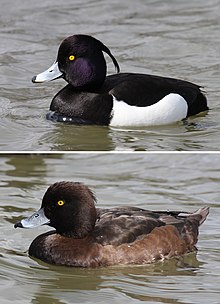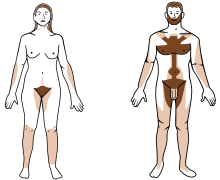Sexual dimorphism

Sexual dimorphism ( Latin sexus "gender", and ancient Greek δίμορφος dímorphos , German , two polymorphic ' ), sexual dimorphism , or secondary sex characteristic referred to in the biology clear differences in appearance between sexually mature male and female individuals of the same (animal) type , which is not the Genital organs are related; Examples are different body sizes or body colors of females and males .
Morphology: differences in appearance
In many animals, the secondary sexual characteristics that develop with sexual maturity are permanent; other species only show sexual dimorphism at mating season . There is often a connection between sex hormones , the resulting different courtship clothes , the different behavior during mating and the parental care for the offspring based on division of labor. The macroscopic sexual dimorphisms are genetically determined. The manifold physiological differences range from the hormonal system to the general metabolism to the control of growth processes and the formation of preferences.
height

The males are larger or smaller than the females. In mammals and many birds , the males are often larger than the females. In contrast, in birds of prey such as birds of prey and owls , in reptiles , toads and arthropods, the female is often larger than the male. The extreme case are the dwarf males : In some deep-sea fish such as deep-sea anglerfish , the males degenerate into "appendages" of the female, with which they are completely fused and through whose bloodstream they are also nourished. It is similar with the green hedgehog worm , in which the dwarf males live inside the female and also fertilize the eggs there.
coloring
If the body surfaces of the sexes differ in color, this is called sexual dichroism (for example, plumage color in birds , fur color in mammals , scale color in fish ).

Different organ training
In some animal species, the sexes form organs of different shapes. These can be weapons for the fight between the males (e.g. the horns of sheep or enlarged canines as in wild boars , two-toothed whales , musk deer ), features to draw the attention of a sexual partner (e.g. the cockscomb or scent glands for pheromones or tail feathers of pheasants ) or sensors to perceive the stimuli of a sexual partner (e.g. the antennae of butterflies ). In mammals, males and females can various distinct body hair have (z. B. the breast and Bartbehaarung of people , mane many lions).
Additional organ formations
In some animal species, one of the sexes produces additional organs. These can be weapons for rivalry (e.g. the antlers of the deer or the spurs of the roosters ), features to draw the attention of a sexual partner (e.g. the peacock wheel or light organs in fireflies ) or organs for brood care (e.g. . fully developed mammary glands in female mammals, externally recognizable as female breast or udder ; brood pouches in pipefish or marsupium of woodlice or echinoderms ).
Ethology: differences in behavior
Often the sexes show different behaviors. These are called the tertiary sex characteristics. The differences often intensify during courtship ; they are usually directly related to the search for and choice of partner. One example is the song of the male songbirds . This can also include protracted behavior patterns for the construction of facilities by one of the sexes, such as nest building for the upcoming brood care (e.g. by woodpeckers or Siamese fighting fish ) or devices suitable for courtship (such as arbors by bowerbirds ).
Explanation of the differences

The cause of all secondary sexual characteristics are gender-specific selection pressures , which are subject to both external ( natural ) and sexual selection .
In many species with promiscuous mating behavior, males can potentially produce significantly more offspring than females. The females of these species show more choosy behavior than the males when it comes to choosing a partner. It increases the biological fitness of the offspring of the females if, in this mating behavior, they select those males whose characteristics are of particularly high quality. This in turn leads to the fact that predominantly males with a strong expression of these characteristics mate, which results in sexually determined selection pressure. Conversely, it increases the success of the males if they mate with as many females as possible, which also creates a corresponding selection pressure.
For breeding success it is advantageous if the offspring grow up protected from predators . Parents who care for the brood are therefore mostly inconspicuous and well camouflaged in their habitat .
If brood care is only carried out by one parent, this behavior on the one hand represents an ethological sexual dimorphism and, on the other hand, favors the development of further sexual dimorphisms, since the requirements for brood care are gender-specific. A pronounced gender dimorphism can also be a measure of the degree of ethological differences between the sexes; this often concerns differences in mating behavior such as polygyny or, less often, polyandry .
There are a number of species in which the females are larger than the males because the female lays large numbers of eggs, such as insect queens , or because it increases her childbearing ability.
Another explanation comes without any recognizable evidence of a clear advantage and primarily blames a self-reinforcing sexual preference. For example, the influence of sexual preference for certain body sizes in reef-dwelling fish was investigated.
Rensch's rule
The Rensch rule, formulated in 1950 by the German zoologist Bernhard Rensch , is an allometric rule for the sex-specific size difference in animals. It says that among related species, size differences are more pronounced in larger species and that in large species the males and in small species the females tend to be larger.
The animal groups that follow this pattern include reptiles in particular , but also primates , seals , ungulates , shorebirds, hummingbirds and mites that visit flowers .
See also
- Dimorphism (two different occurrences of the same species)
- Polymorphism (several gene variants within a population)
literature
- Charles Darwin : Human Descent and Sexual Selection . 2nd volumes. 3rd, completely revised edition, translated from English by Julius Victor Carus . In: Ch. Darwin's collected works , volumes 5 and 6. Schweizerbart'sche Verlagshandlung / Koch, Stuttgart 1875 ( volume 1 and volume 2 at Wikisource ).
- Ronald Fisher : The Genetical Theory of Natural Selection. Oxford University Press, New York 1930 (English; new edition 1999: ISBN 0-19-850440-3 ).
- Matt Ridley: Eros and Evolution. The natural history of sexuality. Droemer Knaur, Munich 1998, ISBN 3-426-77315-5 .
Documentaries
- Véronique Kleiner: Why are women shorter than men? ARTE France , France 2013 (52 minutes, info from Arte ; international scientists from various disciplines on evolutionary history).
Web links
- Gerhard Medicus : Questions about the gender difference - a behavioral approach. (PDF; 108 kB) 2000, accessed on January 25, 2014 (8 pages; see associated source / overview / guideline ).
- Gerhard Medicus, Sigrid Hopf: Ethology: Biopsychology of the gender difference. In: Introduction to Human Ethology. University of Innsbruck, 1995, accessed on January 25, 2014 (PDF documents).
Individual evidence
- ↑ Erich Pertsch: Langenscheidts Large School Dictionary Latin-German . Langenscheidt, Berlin 1978, ISBN 3-468-07201-5 .
- ^ Wilhelm Gemoll : Greek-German school and hand dictionary . Freytag / Hölder-Pichler-Tempsky, Munich / Vienna 1965.
- ↑ Entry: Sexual Dimorphism. In: Lexicon of Biology . Volume 7, Herder, Freiburg.
- ↑ Bernhard Rensch: The phylogenetic special position of humans . 1957, p. 33.
- ^ Wolfgang Clauss, Cornelia Clauss: Humanbiologie compact . Springer, 2009, p. 348.
- ^ Brian J. Olsen, Russell Greenberg, Jeffrey R. Walters, Robert C. Fleischer: Sexual dimorphism in a feeding apparatus is driven by mate choice and not niche partitioning. In: Behavioral Ecology , 24, No. 6, 2013, pp. 1327-1338, doi: 10.1093 / beheco / art071 .
- ↑ a b c Stefan PW Walker, Mark I. McCormick: Sexual selection explains sex-specific growth plasticity and positive allometry for sexual size dimorphism in a reef fish. In: Proceedings of the Royal Society B: Biological Sciences , 276, No. 1671, September 22, 2009, 3335-3343, doi: 10.1098 / rspb.2009.0767 .
- ↑ a b James Dale, Peter O Dunn, Jordi Figuerola, Terje Lislevand, Tamás Székely, Linda A Whittingham: Sexual selection explains Rensch's rule of allometry for sexual size dimorphism. In: Proceedings of the Royal Society B: Biological Sciences , 274, No. 1628, December 7, 2007, pp. 2971-2979, doi: 10.1098 / rspb.2007.1043 .
- ↑ Ehab Abouheif, Daphne J. Fairbairn: A comparative analysis of allometry for sexual size dimorphism: assessing Rensch's rule . In: American Naturalist , 149, No. 3, March 1997, pp. 540-562, JSTOR 2463382 .
- ^ Robert M. Cox, Marguerite A. Butler, and Henry B. John-Alder: The evolution of sexual size dimorphism in reptiles . (PDF) In: Sex, Size and Gender Roles: Evolutionary Studies of Sexual Size Dimorphism. 2007, pp. 38-49.
- ^ DJ Fairbairn: Allometry for sexual size dimorphism: Pattern and process in the coevolution of body size in males and females . In: Annual Review in Ecology and Systematics , 28, 1997, pp. 659-687, JSTOR 2952508 .
- ↑ Tamás Székely, Robert P. Freckleton, John D. Reynolds: Sexual selection explains Rensch's rule of size dimorphism in shorebirds. In: Proceedings of the National Academy of Sciences of the United States of America 101, No. 33, 2003, pp. 12224-12227, doi: 10.1073 / pnas.0404503101
- ^ RK Colwell: Rensch's rule crosses the line: convergent allometry of sexual size dimorphism in hummingbirds and flower mites . In: The American Naturalist , 156, 2000, pp. 496-510, JSTOR 10.1086 / 303406 .